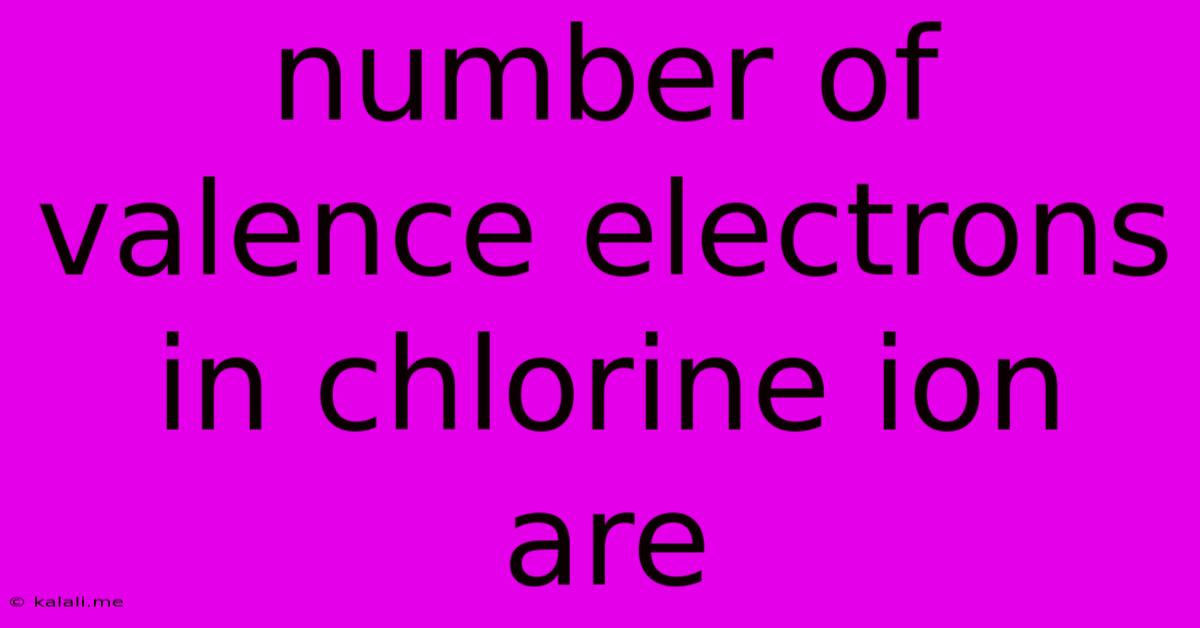Number Of Valence Electrons In Chlorine Ion Are
Kalali
Jun 15, 2025 · 3 min read

Table of Contents
The Number of Valence Electrons in a Chlorine Ion: A Deep Dive
Meta Description: Understanding the number of valence electrons in a chlorine ion is crucial for comprehending its chemical behavior. This article explains the concept clearly, detailing electron configuration and ionic bonding.
Chlorine, a vital element in many aspects of our lives, exhibits fascinating behavior when it forms ions. Knowing the number of valence electrons in a chlorine ion is key to understanding its reactivity and how it interacts with other elements. This article will dissect the electron configuration of chlorine and its ion, explaining how the number of valence electrons changes during ion formation.
Understanding Valence Electrons
Before delving into the specifics of chlorine ions, let's briefly revisit the concept of valence electrons. Valence electrons are the electrons located in the outermost shell of an atom. These electrons are the primary participants in chemical bonding, determining an atom's reactivity and the types of bonds it can form. They dictate how an atom will interact with other atoms to achieve a stable electron configuration, often resembling that of a noble gas.
Chlorine's Atomic Structure
Chlorine (Cl) has an atomic number of 17, meaning it possesses 17 protons and, in a neutral atom, 17 electrons. Its electron configuration is 1s²2s²2p⁶3s²3p⁵. This means:
- Shell 1: 2 electrons (1s²)
- Shell 2: 8 electrons (2s²2p⁶)
- Shell 3: 7 electrons (3s²3p⁵)
The outermost shell (shell 3) contains 7 valence electrons. This is why chlorine is highly reactive; it readily gains one electron to achieve a stable octet (8 electrons) in its outermost shell.
Formation of the Chloride Ion (Cl⁻)
To achieve a stable electron configuration resembling the noble gas argon (Ar), chlorine readily accepts one electron. This process results in the formation of a chloride ion (Cl⁻). The added electron fills the 3p subshell, completing the octet.
Valence Electrons in the Chloride Ion
Crucially, the addition of this extra electron changes the number of valence electrons. The chloride ion (Cl⁻) now has 8 valence electrons—a full octet. These 8 electrons represent a stable, low-energy configuration, making the chloride ion relatively unreactive compared to its neutral chlorine atom counterpart.
Importance of Valence Electrons in Chemical Bonding
The change in the number of valence electrons from 7 to 8 dramatically affects chlorine's chemical behavior. The strong drive to gain that extra electron and achieve a stable octet is the driving force behind chlorine's ability to form ionic bonds with other elements, particularly metals. Understanding this principle is essential to predicting the behavior of chlorine in chemical reactions and the formation of various compounds.
Summary: Valence Electrons in Chlorine and its Ion
- Neutral Chlorine Atom (Cl): 7 valence electrons
- Chloride Ion (Cl⁻): 8 valence electrons
This seemingly small change in the number of valence electrons has a profound impact on chlorine's chemical properties and its role in forming various chemical compounds. Understanding valence electrons is fundamental to grasping the principles of chemical bonding and reactivity.
Latest Posts
Latest Posts
-
The Elements In Group 18 Are Called The
Jun 15, 2025
-
Least Common Multiple Of 20 And 18
Jun 15, 2025
-
Which Of The Following Is An Example Of New Media
Jun 15, 2025
-
According To Dalton Atoms Of Different Elements Will Be
Jun 15, 2025
-
Match The Words With Their Meanings Answer
Jun 15, 2025
Related Post
Thank you for visiting our website which covers about Number Of Valence Electrons In Chlorine Ion Are . We hope the information provided has been useful to you. Feel free to contact us if you have any questions or need further assistance. See you next time and don't miss to bookmark.